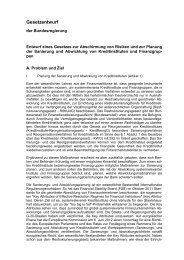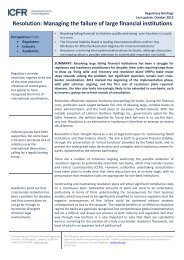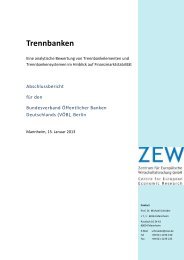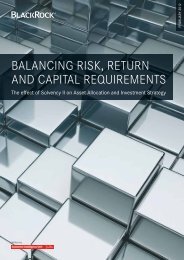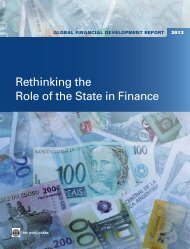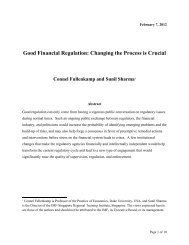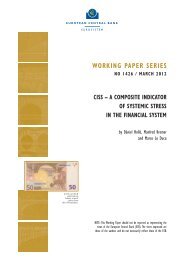A Proposal for the Resolution of Systemically Important Assets and ...
A Proposal for the Resolution of Systemically Important Assets and ...
A Proposal for the Resolution of Systemically Important Assets and ...
Create successful ePaper yourself
Turn your PDF publications into a flip-book with our unique Google optimized e-Paper software.
transactions, called term repos, have terms longer than one day but shorter than one year,<br />
although <strong>the</strong> vast majority have maturities <strong>of</strong> three months or less. Participants in <strong>the</strong> repo<br />
market include commercial banks, investment banks, hedge funds, mutual funds, pension<br />
funds,moneymarketfunds,municipalities,corporations,<strong>and</strong>o<strong>the</strong>rowners<strong>of</strong>largeamounts<strong>of</strong><br />
idlecash,aswellas<strong>the</strong>Fed<strong>and</strong>primarysecuritiesdealers.<br />
<br />
The Fed participates in <strong>the</strong> repo market mainly to implement its monetary policy;<br />
primary securities dealers participate mostly to finance <strong>the</strong>ir marketmaking <strong>and</strong> risk<br />
managementactivities.On<strong>the</strong>o<strong>the</strong>rh<strong>and</strong>,owners<strong>of</strong>largeamounts<strong>of</strong>idlecashengagein<strong>the</strong><br />
repo market mainly <strong>for</strong> two reasons: (1) to get better interest rates in <strong>the</strong> repo market<br />
compared with deposits at commercial banks, <strong>and</strong> (2) <strong>for</strong> insurance purposes; while large<br />
depositsatcommercialbanksarenotinsured,depositsat“repobanks”aresecuredbydebt<br />
usedascollateral.<br />
<br />
III.IEvolution<strong>of</strong><strong>the</strong>U.S.RepoMarket<br />
<br />
Thereposwereintroducedto<strong>the</strong>U.S.financialmarketby<strong>the</strong>FederalReservein1917.<br />
Reposallowed<strong>the</strong>Fedtoextendcredittoitsmemberbanks,afterawartimetaxoninterest<br />
paymentsoncommercialpaperhadmadeitdifficult<strong>for</strong>bankstoraisefundsin<strong>the</strong>commercial<br />
paper market. Later in <strong>the</strong> 1920s, <strong>the</strong> New York Fed used repos secured with bankers’<br />
acceptancestoextendcredittodealerstoencourage<strong>the</strong>development<strong>of</strong>aliquidsecondary<br />
market<strong>for</strong>acceptances.Reposfellfromgraceduring<strong>the</strong>GreatDepressionaftermassivebank<br />
failures <strong>and</strong> low interest rates, only to make a comeback after <strong>the</strong> TreasuryFederal Reserve<br />
Accord<strong>of</strong>1951“thatrenewedemphasisoncontrollinginflationra<strong>the</strong>rthankeepinginterest<br />
rateslow”(Garbade,2006).<br />
<br />
Early repos in <strong>the</strong> U.S. had two distinguishing features. First, accrued interest was<br />
excludedfrom<strong>the</strong>price<strong>of</strong><strong>the</strong>reposecurities.Second,eventhough<strong>the</strong>creditorcouldsellor<br />
deliver <strong>the</strong> repo securities to settle a prior sale at prices that included <strong>the</strong> accrued interest<br />
during<strong>the</strong>term<strong>of</strong><strong>the</strong> repo,ownership<strong>of</strong><strong>the</strong> reposecuritiesrestedwith<strong>the</strong>debtor. These<br />
features had <strong>the</strong> following implications: (1) <strong>the</strong> repo securities were underpriced; (2) <strong>the</strong><br />
creditor had to remit to <strong>the</strong> debtor any coupon payments on <strong>the</strong> repo securities during <strong>the</strong><br />
term<strong>of</strong><strong>the</strong>repo;<strong>and</strong>(3)in<strong>the</strong>event<strong>of</strong>abankruptcy<strong>of</strong><strong>the</strong>debtor,<strong>the</strong>reposecuritieswere<br />
subjecttoautomaticstay;thatis,<strong>the</strong>creditorcouldnottakeownership<strong>of</strong><strong>the</strong>reposecurities<br />
<strong>and</strong>sell<strong>the</strong>mimmediately. 13 Thesefeaturesremainedintactuntil<strong>the</strong>early1980s.<br />
<br />
13 However, <strong>the</strong>re appears to have been some deliberate vagueness about this until a government securities<br />
dealer,LombardWall,collapsedin1982,<strong>and</strong><strong>the</strong>FederalBankruptcyCourt<strong>of</strong>NewYorkimposedanautomatic<br />
stayon<strong>the</strong>reposecuritiesthatLombardWallhadusedascollateral.See:<br />
http://www.nytimes.com/1982/12/17/business/lombardwall.html<br />
Thispointhadalwaysbeenuncertainuntil<strong>the</strong>1982<strong>and</strong>1984amendmentstoCode11<strong>of</strong><strong>the</strong>U.S.Bankruptcy<br />
Code.Ina“truesale,”<strong>the</strong>buyerisnotsubjectto<strong>the</strong>automaticstay.Forinstance,ifanautomobiledealerbought<br />
acarfromGM<strong>the</strong>daybe<strong>for</strong>eitfiled<strong>for</strong>bankruptcy,itcouldresell<strong>the</strong>carwithoutasking<strong>for</strong>permission<strong>of</strong><strong>the</strong><br />
court.However,if<strong>the</strong>dealwerefinancedbyGM,<strong>the</strong>dealerwouldneedacourtordertosell<strong>the</strong>car.Therepo<br />
<br />
15



